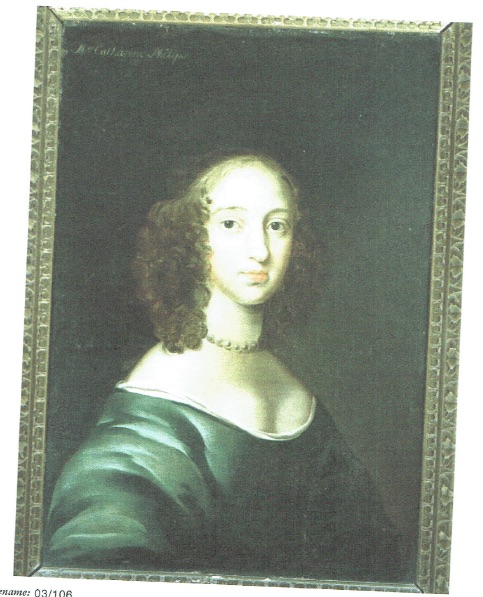Katherine Philips
Katherine Philips (1632-1664) had one of the most interesting and richest–if short–writing careers of any poet in English in the seventeenth century. Philips is remembered now as a coterie poet, that is, a poet whose first audience was family and friends, intimate acquaintances who knew her well. Philips made friendship and family into the major themes and topics of her poetry. She gave her friends code names: her husband James, for example, was known in her poems as “Antenor”; her best female friend Ann Owen was called “Lucasia”; Philips identified herself in her poetry as “Orinda.” Toward the end of her short life (she died of smallpox in 1664; she was only 32), Philips was becoming more widely known to readers in England when her works, which had previously circulated only in manuscript copies, began to be given a wider circulation through being printed for the first time. Critics and readers hailed her as the “matchless Orinda” for the elegance of her writing and the calm intelligence and grace of the persona she constructed for herself in her verse. She also did some translations of French plays into English. She translated Pierre Corneille’s tragedy La Mort de Pompee from French into English and it was performed in Dublin and then in London. At the time of her death, she was working on a translation of Corneille’s play Horace. For decades to come, the figure of “Orinda” lived on in the memory of readers, becoming the idealized emblem of the female writer, the literary lady whose talent and moral virtue shone through her work.

Because so much of her writing is about her friends, and because her career possibilities were so fully shaped by the political transformations that she witnessed in her lifetime, it is worth giving attention to her life story. Philips was born as Katherine Fowler in London in 1632. Her father was a cloth merchant, and her family seems to have shared the Puritan affinities that were common in middle-class trading circles in that era. But after her marriage to James Philips–a 24-year-old widower who was related to her stepfather–in 1648, Katherine spent most of her adult life in the countryside, in Wales, and seems to have been sympathetic to the royalist cause and to more conventional Anglicanism–even though her husband was himself affiliated with the anti-Royalist Parliamentary cause and the Commonwealth government that ruled Britain from 1649 to 1660. (For many years, it was believed that James Philips was 54 years old at the time of the marriage, but that has been corrected recently; in spite of his comparative youth, however, he was already widowed, and would be again when Katherine died in 1664). In spite of the difference in their ages, and the split in their political sympathies, Katherine and James seem to have had a happy marriage. James’s poetic name “Antenor,” given to him by Katherine, refers to the ancient Trojan who tried to make peace between Greece and Troy during the Trojan War, suggesting that Katherine admired her husband’s moderation and desire to find common ground between opposing camps.
Living and Wales, far from her London family, Philips may have used poetry as a means of keeping in contact with her circle of friends and relatives. And, too, writing about friendship, giving pet names to acquaintances, became popular among people associated with the British court during the years of the Commonwealth in the 1650s, when part of the Stuart court was in exile, and when its sympathizers in Britain itself had to lie low. Idealizing friendship and Platonic love was a good way of keeping family bonds and the court culture alive, and coteries such as Philips’s emerged as ways in which the identity of a group was kept alive in spite of distance and political hazards.
Philips’s friends read her poems in manuscript, perhaps in a copy that Philips herself wrote out. Such a copy is called an “autograph” copy, and one of these that contains many of Philips’s poems has survived. Other copies would be made by friends or by professional scribes. With so much hand-copying going on, changes, revisions, and mistakes are very common. Poems circulated in this way often exist in multiple versions, as authors revised their works over time, or, perhaps, as others in the coterie amended the original text. Often, the manuscript versions are so different from one another that we will never know which one is the real, authoritative version. Or, maybe even better, the conditions of coterie writing and “publication” remind us that in many cases the idea of a single authoritative text is more an illusion than a reality; texts are always changeable, subject to forces well beyond their originator’s control.
In such a context, having one’s poems printed for general readers seems like a violation of privacy, as it exposes texts that were intended for an audience of people you know intimately. When Philips’s poems were first printed, it was because an unscrupulous publisher managed to get hold of a manuscript copy and printed them against her will. Philips was angry, and managed to get what she called “this false Edition of my Verses” suppressed. It was only in 1667, three years after her death, that a family friend, Sir Charles Cotterell, perhaps working in collaboration with James Philips, published a handsome printed edition of her poetry that helped set the terms under which her writing was read and interpreted for generations. For a long time after her death, Katherine Philips lived on in the memory of readers as “Orinda,” the ideal of a woman writer, living a life of elegant retirement and writing beautiful verse on domestic topics. This was an idealization that does not capture the range of Philips’s engagements and interests, which included religion, philosophy, and politics. Philips was a poet of great technical gifts and complex political affiliations whose career was about to enter a new and more public phase when it was interrupted by her death.
